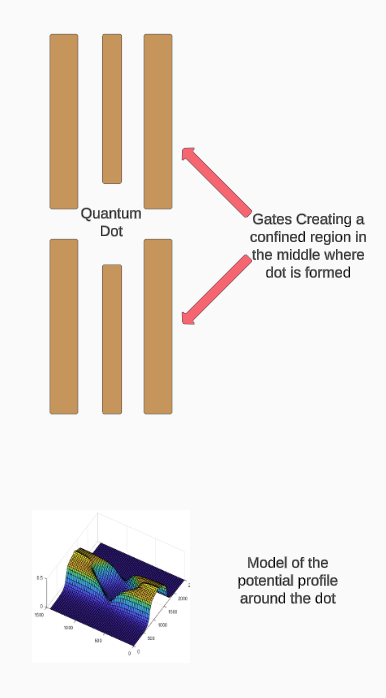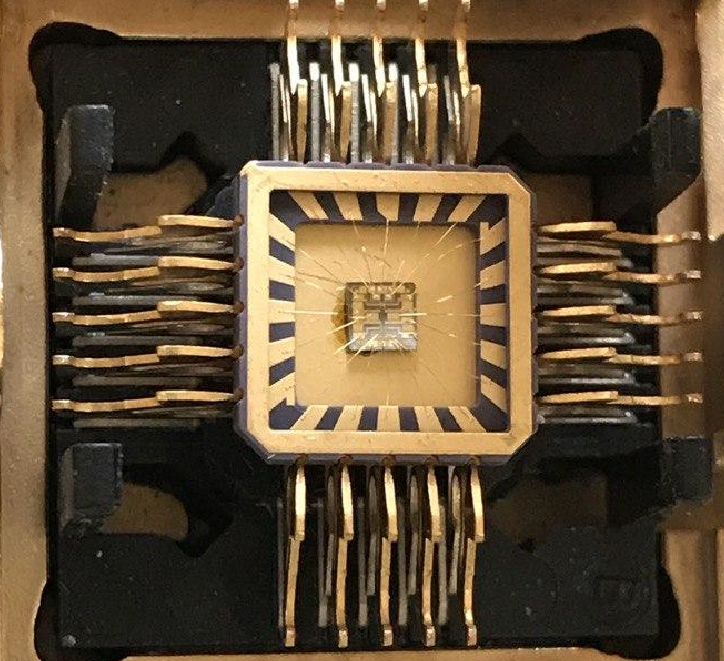What is a Quantum Dot?
A quantum dot is a confined spacial region in a semiconductor structure or semiconductor particles in scales of a few nanometers. Due to the spatial confinement in all directions, quantum dots, as the name suggests exhibit quantum mechanical behaviour. Such behaviour has optical and electronic properties of interest which could be applied to many areas of science and technology.

Creation of Quantum Dots
The confinement resulting in a Quantum Dot can come in different ways, mainly through electrostatic confinement [1], colloidal synthesis [2] and self-assembly [3].
Electrostatic confinement can be created through metallic gates placed at the surface of a semiconductor heterostructure with a 2DEG sandwiched in the middle. With an appropriately applied negative voltage on these gates, a quantum well confined in all dimensions (therefore a quantum dot) could be created [1]. Furthermore, one can also consider the confinement created by lattice defects, dopants or other impurities as electrostatically confining a region therefore creating a quantum dot. Gate-defined quantum dots allow precise control and measurement of small charges and therefore are used in both exploring the fundamental physics of quantum dots and also in information processing and sensing technologies [4]
Colloidal synthesis refers to nanocrystals synthesised through chemical solutions. This is a liquid-phase synthesis process and includes various reactions. Approaches to this process are divided into two main categories through the chemical reactors used - batch or continuous [2]. The scalability of this method makes it promising for certain commercial applications such as in solar and luminescence [5][6].
Self-assembled quantum dots are created through defects that form when the material is grown on a substrate that is not lattice-matched. This results in certain islands in which the surrounding confinement forms a quantum dot [3]. Self-assembled quantum dots are fabricated through epitaxial techniques and can be used in electro-optical applications [7].
Applications of Quantum Dots
There is a wide range of technological applications of quantum dots, some of these are:
Single Photon sources [8]
Single Electron transistors [9][10]
Spin Qubits [11]
Medical Imaging, Drug Delivery and Biosensing [12]
Photonics and Electro-Optics [13]
There is more evaluation and explanation to make for the mentioned areas and articles above. The use of quantum dots and their development both in our understanding of its physics and also implementation in technology is rapidly developing but still at its early stages of development.
References
[1] M. Ciorga et al., Addition spectrum of a lateral dot from Coulomb and spin-blockade spectroscopy, Phys. Rev. B 61, R16315(R) ( 2000).
[2] Y. Pu et al., Colloidal Synthesis of Semiconductor Quantum Dots toward Large-Scale Production: A Review, Ind. Eng. Chem. Res. 57, 1790 (2018).
[3] D. Leonard et al., Critical layer thickness for self-assembled InAs islands on GaAs, Phys. Rev. B 50, 11687 (1994).
[4] G. Schmid, Nanoparticles from theory to application (John Wiley & Sons, 2010).
[5] H. Zhao and F. Rosei, Colloidal Quantum Dots for Solar Technologies, Chem 3, 229 (2017).
[6] J. Owen and L. Brus, Chemical Synthesis and Luminescence Applications of Colloidal Semiconductor Quantum Dots, J. Am. Chem. Soc. 139, 10939 (2017).
[7] Q. Hao et al., Development of Self-Assembly Methods on Quantum Dots, Materials 16, 1317 (2023).
[8] P. Senellart et al., A. High-performance semiconductor quantum-dot single-photon sources, Nat. Nanotech. 12, 1026 (2017).
[9] K. Shibata et al., Single PbS colloidal quantum dot transistors, Nat. Commun. 14, 7486 (2023).
[10] L. Zhuang et al., Silicon single-electron quantum-dot transistor switch operating at room temperature, Appl. Phys. Lett. 72, 1205 (1998).
[11] J. R. Petta et al., Coherent Manipulation of Coupled Electron Spins in Semiconductor Quantum Dots, Science 309, 2180 (2005).
[12] C. T. Matea et al., Quantum dots in imaging, drug delivery and sensor applications. Int. J. Nanomed. 12, 5421 (2017).
[13] P. Prabhakaran et al., Quantum dots (QDs) for photonic applications, Opt. Mater. Express 2, 578 (2012).
